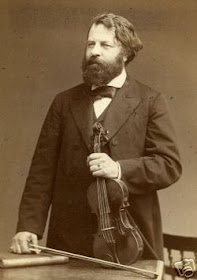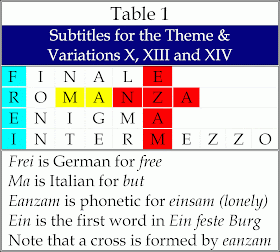 |
| Joseph Joachim (1831-1907) |
Frei aber einsam. (Free but lonely)
But Jesus often withdrew to lonely places and prayed.
Variation XIII from Elgar's Enigma Variations contains four Mendelssohn fragments in three different keys: F minor, A-flat major, and E-flat major. Elgar’s choice of keys for these fragments points to a famous motto that inspired a work for violin and piano, the F-A-E Sonata. This piece in four movements is dedicated to Joseph Joachim, a renowned violinist during the nineteenth and early twentieth centuries who supported the music of Liszt and Wagner, and later championed the works of Schumann and Brahms. The letters “F. A. E.” are the acronym for Joachim’s personal motto, “Frei aber einsam” (Free but lonely).
In his youth, Elgar desperately wanted to become a famous violin soloist, something beyond his grasp since he began his formal instruction with Adolph Politzer much too late. Joachim was one of the most celebrated violin soloists of his generation, so Elgar's admiration for him is understandable. Joachim's association with composers whom Elgar deeply admired, particularly Wagner and Schumann, surely intensified that fascination for one of the great violin soloists of the age and a favorite of Queen Victoria. Elgar's deliberate pairing of Joachim's personal motto with Mendelssohn's music makes complete sense because Joachim was a protégé of Mendelssohn. At the age of 12 Joachim performed Beethoven's violin concerto in London under the direction of Mendelssohn, and he remained a perennial favorite with the British nation for the duration of his career.
The F-A-E Sonata was a collaborative work by Robert Schumann, Johannes Brahms, and Schumann’s pupil, Albert Dietrich. The sonata was composed using a musical motif based on the notes F, A and E to represent the initials of Joachim’s highly romanticized motto. Dietrich composed the first movement in Sonata form, Schumann an Intermezzo for the second movement, Brahms a Scherzo for the third movement, and Schumann a Finale for the fourth. The titles of Schumann’s contributions match those for two movements of the Enigma Variations: Intermezzo and Finale. Elgar's allusion to Schumann could not be more apparent. The motto’s German origins serve as a vital clue about the language of the missing Principal Theme, Ein feste Burg.
A second, less obvious allusion to Joachim’s motto is found in four subtitles given for the Theme (Enigma), Variations X (Intermezzo), XIII (Romanza), and XIV (Finale). As shown in Table 1, the first letter of each subtitle is an anagram for frei. When the subtitles are arranged correctly so the first letter of each spells frei, the sixth letters conveniently form an approximate phonetic spelling of einsam as “ezam”. When the letters immediately before and after z in Romanza are included, this permits a complete phonetic spelling of einsam as “eanzam”. It is fascinating that these extra letters form the outline of a cross, and happen to do so with the subtitle Romanza. Remarkably the Italian word ma which translates as but is formed between frei and “eanzam”.
There is a revealing connection between Joseph Joachim, a Jew who converted to the Lutheran faith in 1855. and the secret friend of Variation XIII. In 1891, Joachim was granted the rare opportunity to play Antonio Stradivari's fabled violin named the Messiah. In this historical context, Elgar's musical allusion to Joachim within Variation XIII serves as a carefully crafted reference to the hidden friend, Jesus of Nazareth. In Christianity, Jesus is commonly referred to as the Messiah. The allusion to Joseph Joachim is revealing because Jesus' earthly father was named Joseph. In later life, Elgar slyly suggested Variation XIII was dedicated to Lady Mary Lygon. While this theory is easily refuted, it is a rather striking coincidence the mother of Jesus was also named Mary. In Roman Catholicism, she is often referred to as Lady Mary.
It has been credibly shown Elgar makes multiple references to the musical cryptogram Frei aber einsam in the Enigma Variations. These allusions to one of classical music’s most familiar musical cryptograms are fitting because Elgar once wrote the Enigma Theme "expressed when written . . . my sense of the loneliness of the artist." Free but lonely. Elgar's mastery of wordplay and ciphers is on full display. Not only is a familiarity with the German and Italian languages necessary to discern this linguistic cipher; it is equally vital to discern the three-word title of the covert Principal Theme, Ein feste Burg. Three words in German – are these not an obvious clue? There is also a credible connection between the initials F.A.E. and the literal English translation of the unstated Principal Theme, A Mighty Fortress. To learn more about the secrets of the Enigma Variations, read my free eBook Elgar’s Enigmas Exposed. Please support my original research by becoming a sponsor on Patreon.

Very interesting ! I'd love for you to have a crack at the enigma of the fiddle concerto as well! Thanks for posting this.
ReplyDeleteBest,
Odin Rathnam
Thank you, Odin Rathnam, for your comment. In one of my most popular posts, 'Jesus, Elgar and the Violin.....', I delve into the very subject you ask me to address.
ReplyDeletehttp://enigmathemeunmasked.blogspot.com/2010/09/jesus-elgar-and-violin.html